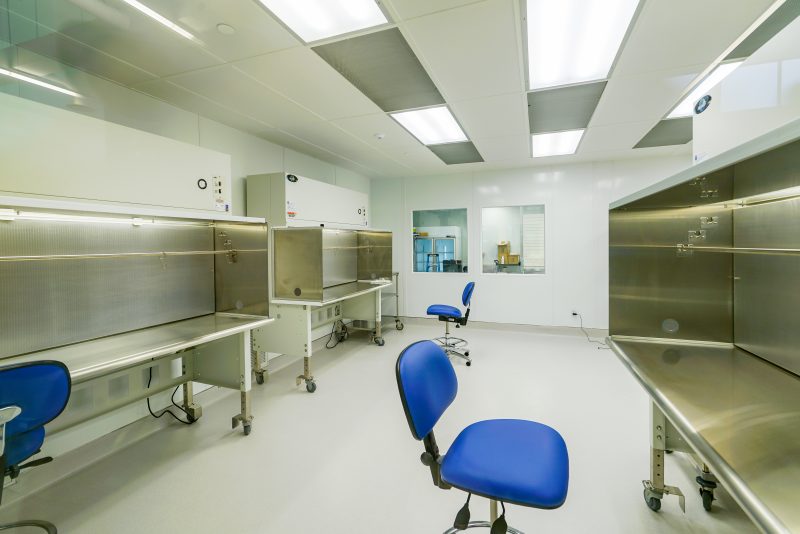Cleanroom classifications and standards are an important part of cleanroom design and development. They regulate many cleanroom aspects, including levels of air cleanliness, air exchange rates, workflow, pressure, and more.
While we usually discuss ISO standards, there are plenty of other cleanroom standards that help us design and build highly effective and controlled environments that are specific to an industry — one of them being USP standards. Let’s discuss what USP standards are and how to know if your cleanroom must comply with them.
What Are USP Standards?
The United States Pharmacopeia (USP) is an independent, scientific nonprofit organization that establishes and enforces quality standards for pharmaceutical products. USP standards help protect patient and worker safety while developing, packaging, distributing, and consuming medicines and dietary supplements. They’re often used to inform decisions made by the United States Food and Drug Administration (FDA), and they’re an important set of standards to keep in mind when it comes to designing, installing, and operating cleanrooms.
USP Standards vs. ISO Standards
USP and ISO are both types of cleanroom quality standards, but they’re not the same.
USP standards are most commonly used for pharmaceutical applications and must be followed along with ISO classification standards. Alternatively, ISO standards are much less specific and are followed by a broad range of industries and applications, including pharmaceuticals.
You may think of this in the same way that you think about squares and rectangles. All squares are rectangles, but only some rectangles are squares. Similarly, all cleanrooms follow an ISO standard, but only some need to adhere to both ISO and USP standards.
Who Needs to Follow USP Standards for Cleanrooms?
So, how do you know if you need to follow USP standards while designing, installing, or operating your cleanroom? Simply put, if you’re working with pharmaceutical development or manufacturing, you need to follow USP standards.
Common USP Standards for Cleanrooms
A USP-compliant cleanroom needs to follow all the requirements set by its applicable standard. In pharmaceutical compounding cleanroom applications, USP 797 and USP 800 are the two most common.
While both of these USP standards call for stringent cleanliness requirements, they do have different goals and design specifications. Let’s take a closer look at them below.
USP General Chapter 797 — Sterile, Non-Hazardous Pharmaceutical Compounding Preparation
USP 797 outlines the procedures and requirements for pharmaceutical cleanroom applications that involve compounding sterile products (CSPs). These products are non-hazardous to humans and the surrounding environment, some examples being:
- Syringes
- Injections
- IV medications
- Eye-drops
Compliance with this standard’s requirements is critical — otherwise, pharmaceuticals could be mishandled and cause harm, even death, in patients due to contamination, strength variation, poor-quality ingredients, and more.
As you can likely determine, the most important safety precaution here is ensuring that the pharmaceutical products aren’t altered by external factors like contaminants and operators. For this reason, USP 797 cleanrooms require ISO 7 Classification, required temperature and humidity specifications, and continuous differential positive pressure to minimize airflow from an area with lower air quality classification to an area of higher air quality classification. They also have other requirements relating to:
- Unidirectional airflow using a primary engineering control (PEC) certified to meet ISO Class 5 or better
- Workstation and door placement to facilitate better control
- Operator technique
- Garbing & donning
- Proper hand hygiene
- Regular sanitation & cleanliness protocol
USP General Chapter 800 — Sterile, Hazardous Drug Handling in Healthcare Settings
USP 800 outlines the procedures and requirements for pharmaceutical cleanroom applications that involve hazardous drugs. These products can threaten patients, personnel working in this environment, and the environment. A drug is considered hazardous if it exhibits one or more of the following characteristics in humans or animals:
- Carcinogenicity
- Teratogenicity or developmental toxicity
- Organ toxicity
- Reproductive toxicity
- Genotoxicity
- Structure and toxicity profiles of new drugs that mimic existing hazardous drugs
There are two types of hazardous drugs found in healthcare settings: antineoplastic drugs, which are used to treat cancer, and non-antineoplastic drugs, which are used to treat various other conditions but can pose serious reproductive risks for men and women if they are not managed safely.
Compliance with USP 800 requirements is critical in order to mitigate risk to cleanroom operators as they work with hazardous substances and promote patient safety. Therefore, USP 800 cleanrooms require an ISO 7 Gowning Room with positive pressure, an ISO 7 Cleanroom with negative pressure between 0.01-0.03 inches of water column relative to all adjacent spaces. They also have other requirements relating to:
- Receipt of material
- Safe storage with secure access & detailed product labeling
- Primary Engineering Control (PEC) certified to meet ISO 5 Class or better with external ventilation
- Proper hand hygiene with emergency safety precautions
- Workstation and door placement to eliminate cross contamination
- Garbing & donning
- Regular sanitation & cleanliness protocol
Building a pharmaceutical cleanroom that needs to meet USP 797 or 800 standards? Contact Angstrom Technology. Our cleanroom design experts have experience working on many pharmaceutical and radiopharmaceutical cleanroom projects, and we’re happy to help you build yours in a way that supports your specific needs.



